VR fitness offers chronically ill patients a customizable, engaging exercise solution that adapts to your physical limitations. You’ll experience reduced pain perception, improved strength, and enhanced mental health through immersive environments that distract from discomfort and fatigue. The technology enables longer workout sessions with higher adherence rates than traditional therapy, while providing social connections with others on similar health journeys. Discover how virtual environments can transform your rehabilitation experience while delivering measurable physiological benefits.
Understanding VR Fitness for Chronic Illness
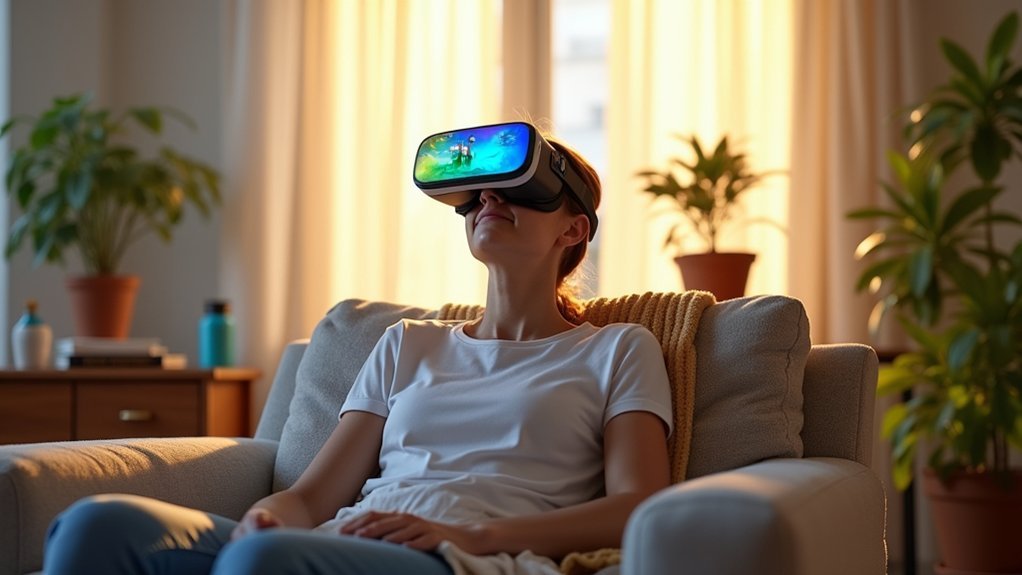
While traditional exercise often presents significant barriers for those managing chronic conditions, virtual reality fitness has emerged as a transformative option that combines physical activity with immersive technology.
You’ll find VR workouts encourage higher chosen work rates and greater engagement compared to conventional exercises, helping overcome inactivity barriers common with chronic illness.
The beauty of VR training lies in its adaptability to your individual physical capacity. Programs can be customized to accommodate your specific limitations, pain levels, and fatigue patterns.
These virtual environments provide controlled, safe settings that minimize injury risk while maximizing benefits. The seated or stationary VR options are particularly beneficial for patients with mobility impairments. The immersive nature of VR also distracts from perceptions of effort and fatigue, allowing you to exercise longer and more consistently, regardless of your condition’s constraints.
Pain Management Benefits Through Virtual Reality
Virtual reality offers remarkable pain management benefits for chronically ill patients, fundamentally changing how you might experience and cope with persistent discomfort. Research shows significant pain score reductions across different medical procedures, particularly in pediatric groups.
When you’re dealing with chronic pain, VR-assisted hypnosis can extend pain-free periods by up to 8.5 hours compared to traditional methods. You’ll find VR effective in perioperative, periprocedural, and chronic pain settings.
The technology’s versatility allows you to select from various relaxing experiences tailored to your needs, accessible on-demand throughout the day for short sessions. This non-invasive approach provides a drug-free analgesic option that many patients find preferable to medication.
While VR is currently studied primarily for acute pain, numerous clinical trials demonstrate its potential for chronic conditions when integrated with existing treatment plans.
How VR Exercise Builds Strength Despite Mobility Limitations
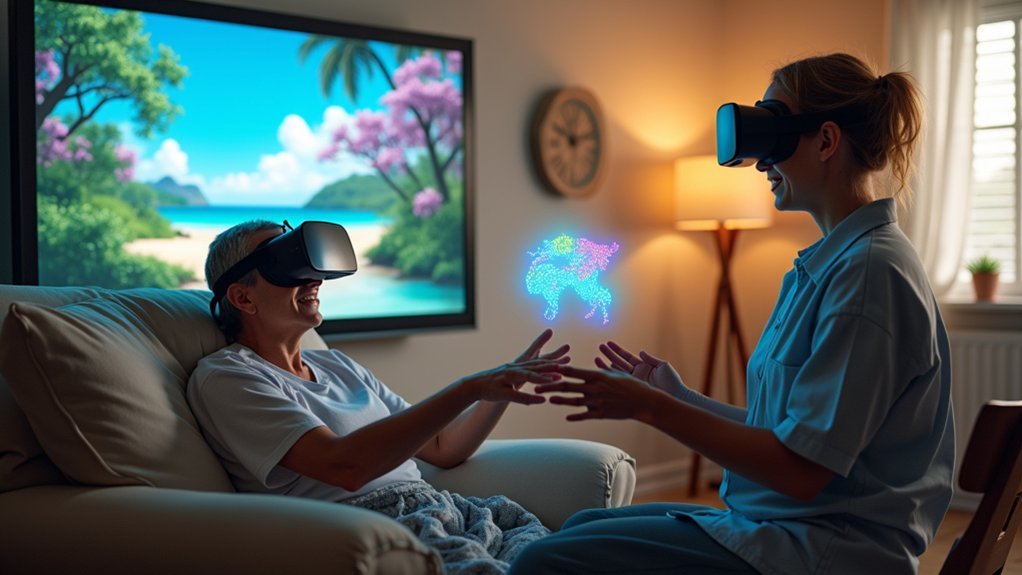
Despite mobility challenges that chronic illnesses impose, virtual reality exercise programs offer you remarkable opportunities to build strength through adaptable, immersive workouts. VR systems create controlled environments where you can safely perform movements tailored to your specific limitations, whether seated or partially supported. Research demonstrates that these VR-based interventions can produce significant improvements in functional fitness for older adults with chronic conditions.
| Condition | Strength Benefits | Exercise Adaptations |
|---|---|---|
| Stroke | Improved motor function | Semi-immersive, supported movements |
| Parkinson’s | Enhanced balance, coordination | Real-time biofeedback for control |
| Spinal Cord Injury | Upper extremity strength | Customized range of motion |
| Chronic Pain | Progressive muscle building | Seated, non-weight bearing options |
Studies show VR exercise stimulates neuroplasticity through repetitive, functional tasks that mimic daily activities. You’ll experience higher adherence rates compared to traditional therapy, thanks to engaging, gamified challenges that make consistent strength-building both possible and enjoyable despite physical limitations.
The Mental Health Advantages of Immersive Fitness
Beyond the physical benefits of exercise, immersive VR fitness offers profound mental health advantages that address the psychological challenges chronically ill patients often face.
You’ll likely experience reduced anxiety and depression as you exercise through a first-person perspective with your personalized avatar.
VR creates a powerful distraction from pain, lowering your perceived exertion while simultaneously increasing your engagement and motivation.
Many patients report enhanced feelings of calmness and improved quality of life as VR experiences reduce stress and improve mood. Research indicates that watching an avatar exercise for 30 minutes can decrease salivary alpha-amylase, a biomarker of stress.
The technology adapts to your specific needs, offering tailored support for anxiety management and cognitive rehabilitation.
With adherence rates reaching 90%, VR fitness provides sustainable mental health benefits through immersive experiences that combat social isolation and promote neuroplasticity—keeping your mind as active as your body.
Personalized VR Fitness Programs for Different Health Conditions
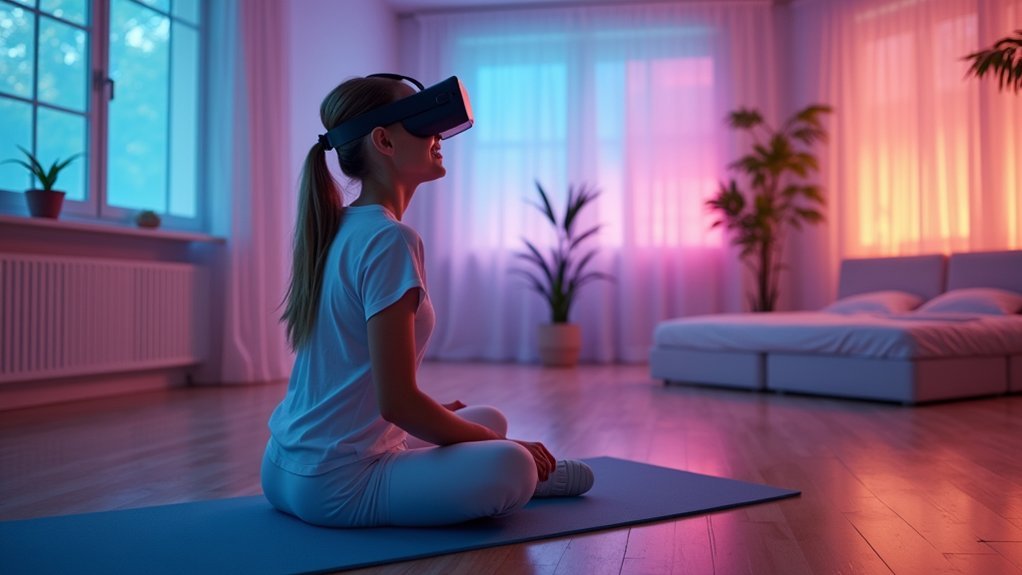
Turning these mental health benefits into practical applications requires specialized approaches for various medical conditions.
For chronic pain sufferers, VR fitness inhibits ascending pain signals while improving mobility and range of motion through customized interventions that adapt to your physical limitations.
If you’re managing musculoskeletal conditions, you’ll find VR exercises specifically tailored to strengthen muscle groups and improve joint health, making recovery less intimidating and more engaging.
Older adults benefit from VR’s dual approach to functional fitness and cognitive stimulation, with adaptive programs that match your physical capacity.
Even dialysis patients show significant improvements in physical endurance and psychological well-being, with evidence-based outcomes supporting VR’s effectiveness across various health conditions. Recent meta-analysis reveals that VR training significantly reduces depression and anxiety in these patients, addressing the emotional challenges of prolonged treatment.
Social Connection Through Virtual Workout Communities
While physical exercise forms the cornerstone of VR fitness, the social connections forged in virtual workout communities deliver equally powerful benefits for chronically ill patients.
These digital spaces break down isolation barriers that often accompany chronic conditions, creating support networks accessible from home. Research supports that chronically ill individuals may experience the same reduced loneliness effects that seniors demonstrated in VR studies.
Virtual wellness communities eliminate isolation’s hold on chronic patients, delivering critical support without leaving home.
When you join virtual fitness communities, you’ll experience:
- Reduced feelings of loneliness through meaningful interactions with fellow participants sharing similar health journeys.
- Increased motivation to maintain exercise routines through friendly accountability and shared progress tracking.
- Lower stress levels as you build supportive relationships that understand your unique challenges.
- Greater enjoyment of exercise through engaging, immersive experiences that feel less like rehabilitation and more like social recreation.
These connections transform solitary workouts into communal experiences, markedly improving long-term adherence to fitness regimens.
Making Exercise Accessible: VR for Wheelchair Users
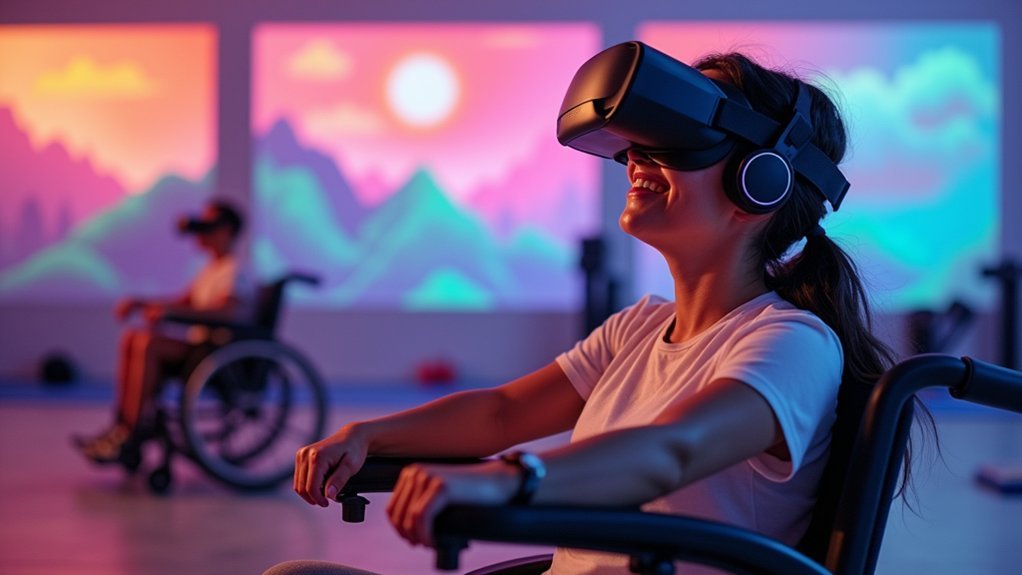
You’ll find VR fitness platforms increasingly tailored with customizable movement options that adapt to your wheelchair mobility needs.
Research shows that seated workouts in virtual environments can provide moderate exercise intensity, delivering meaningful cardiovascular benefits despite mobility limitations.
Modern VR systems now integrate with adaptive equipment, allowing your wheelchair to function as an input device for more immersive and effective training experiences.
Virtual reality training systems provide increased safety while learning wheelchair navigation skills compared to traditional real-world training methods.
Customizable Movement Options
VR technology adapts brilliantly to individual mobility needs, offering wheelchair users unprecedented exercise customization.
You’ll discover virtual environments tailored to your specific abilities and challenges, eliminating the frustration of traditional exercise spaces that weren’t designed with your needs in mind.
- Personalized intensity levels allow you to adjust your workout difficulty as you progress, ensuring you’re always challenged without becoming overwhelmed.
- Skill-building scenarios help transfer VR-learned maneuverability directly to real-world navigation.
- Space adaptation transforms even small home areas into expansive training grounds, bypassing architectural barriers.
- Progressive development tracks your improvement in movement precision and control.
Recent studies show that older adults often prefer seated VR devices to reduce fall risks while still experiencing the benefits of virtual reality exercise.
You’re no longer limited by physical constraints or facility accessibility—VR creates a world where your exercise can evolve alongside your abilities, providing both therapeutic benefits and genuine recreational enjoyment.
Seated Workout Effectiveness
Wheelchair users seeking effective exercise options often face outdated beliefs that seated workouts can’t deliver meaningful results. Research proves otherwise—VR-based seated workouts can burn calories comparable to traditional exercises while generating significant cardiovascular responses.
You’ll likely experience lower perceived exertion during these immersive workouts compared to conventional gym routines, making it easier to sustain longer sessions.
The adaptability of VR technology accommodates various physical abilities, improving motor skills while providing emotional support for those with chronic conditions.
Beyond physical benefits, these engaging experiences enhance motivation—crucial for maintaining consistent exercise habits.
VR environments help reduce stress, improve mood, and boost self-efficacy. The combination of physical activity and immersive distraction creates an effective workout that delivers both physiological and psychological benefits, all from a seated position. Incorporating SMART goals into your VR fitness routine can significantly enhance your commitment to regular physical activity and track meaningful progress over time.
Adaptive Equipment Integration
While traditional fitness equipment often excludes those with mobility challenges, innovative VR systems are bridging this gap through specialized hardware designed specifically for wheelchair users. The TrekEase system exemplifies this advancement by transforming manual wheelchairs into interactive exercise platforms with flywheel resistance.
You’ll find several key adaptations making VR fitness more accessible:
- Sensor-integrated frames that detect wheelchair movement, translating physical actions into virtual experiences like flight simulation.
- Customized software focusing on upper-body engagement rather than walking movements.
- Affordable solutions combining commercial VR headsets ($500 range) with heart rate monitors.
- Community programs offering equipment rentals and loans to increase accessibility.
These developments guarantee you can experience immersive, motivating workouts despite mobility limitations, potentially improving cardiovascular health while making repetitive exercises genuinely engaging. Many users report that VR fitness provides real-time feedback through hand controllers, helping them track progress and maintain proper form during seated workouts.
Measuring Progress: Tracking Improvements in VR Fitness
Accurate measurement forms the cornerstone of any effective fitness routine, especially for chronically ill patients using virtual reality platforms.
You’ll benefit from VR’s extensive tracking systems that monitor not just workout frequency and duration, but also movement accuracy, balance, and coordination—metrics particularly relevant to managing chronic conditions.
Your progress appears through engaging visual representations, including 3D graphs and evolving avatars that make improvements tangible.
Real-time feedback functions like a personal coach, allowing you to adjust form immediately while monitoring heart rate and energy expenditure.
The integration with external health apps creates a thorough health profile, combining VR data with other biometrics.
This synchronization enables your healthcare team to observe long-term trends and make informed adjustments to your personalized fitness journey, keeping you motivated through customized goals and milestone celebrations. Oculus Move provides comprehensive weekly and monthly summaries of your fitness performance, helping you visualize progress over time.
Research-Backed Evidence on VR’s Physiological Impact
You’ll find evidence-backed success through VR fitness as researchers document consistent strength increases and cardiovascular enhancements in chronically ill patients.
Your heart rate, respiratory function, and muscular capability improvements can be precisely measured during and after VR exercise sessions.
These physiological markers provide concrete proof that VR interventions deliver real physical benefits, not just psychological comfort. Studies show that immersive VR applications have demonstrated positive effects on psychological well-being in patients with various chronic conditions including cancer and multiple sclerosis.
Measurable Strength Gains
Research demonstrates that virtual reality fitness programs deliver tangible physiological benefits for chronically ill patients. When using VR exercise regularly, you’ll experience measurable strength improvements regardless of your condition.
Studies confirm VR’s effectiveness across several areas:
- Stroke rehabilitation – Patients show improved balance and extremity function, translating to real-world strength gains.
- Chronic musculoskeletal pain – VR exercise reduces pain while increasing range of motion and functional strength.
- Chronic musculoskeletal pain – VR exercise reduces pain while increasing range of motion and functional strength.
- Spinal cord injuries – VR helps recover lost motor function, contributing to strength restoration.
A three-dimensional VR kayak program shows significant improvements in muscle strength and balance for older adults.
While the evidence is promising, it’s worth noting most studies feature small sample sizes.
However, the consistent positive outcomes across various conditions underscore VR’s potential as a strength-building tool.
Cardio Improvements Tracked
Beyond strength benefits, virtual reality fitness delivers considerable cardiovascular improvements for chronically ill patients. Research confirms VR workouts produce cardio benefits comparable to traditional activities like running and boxing, with users reaching moderate to vigorous intensity levels necessary for respiratory improvement. According to a University of Victoria study, the Supernatural Flow workout provides cardiovascular benefits similar to running.
For cardiac rehabilitation patients, VR exercise greatly enhances exercise capacity while reducing negative emotions that often hinder traditional therapy adherence.
| Cardiovascular Benefit | Clinical Finding | Patient Impact |
|---|---|---|
| Heart Rate Response | Comparable to running/boxing | Renewed confidence in physical capacity |
| Arterial Stiffness | Measurable improvement | Reduced risk of future cardiac events |
| Exercise Capacity | Increased in rehabilitation | Freedom to enjoy daily activities again |
Real-time heart monitoring during VR sessions allows for personalized intensity adjustments, making cardiovascular workouts both safe and effective regardless of your current health status.
VR Equipment Considerations for Different Disabilities
When designing VR fitness solutions for chronically ill patients, equipment considerations must be tailored to specific disabilities to guarantee accessibility and effectiveness. Your chosen VR setup should address both general and specific needs across disability types.
- Visual impairments require audio descriptions, tactile feedback, and high-contrast visual options—consider VR systems with robust audio cues and adjustable visual settings. Haptic feedback devices that simulate touch sensations can significantly enhance navigation and interaction for users who are blind.
- Hearing disabilities need caption options, vibration feedback, and visual cues—look for controllers with haptic responses and VR programs featuring visible indicators.
- Motor limitations demand adaptive controllers, seated experience options, and adjustable gameplay pacing—prioritize ergonomic designs with comfort features.
- General concerns include cost accessibility, space requirements, and sensory overload potential—seek customizable systems that allow users to modify their experience intensity.
Comparing Traditional and Virtual Reality Rehabilitation Methods
You’ll find VR rehabilitation offers considerably higher engagement levels than traditional therapy, with studies showing improved physical function indices and enhanced patient motivation during recovery.
Your personalized VR rehabilitation journey can be precisely tracked through real-time data collection, allowing therapists to adjust your program based on objective progress metrics rather than periodic assessments alone.
This detailed tracking capability enables you to visualize your improvements, potentially accelerating recovery through increased adherence to rehabilitation protocols. Studies demonstrate that VR groups achieved 96% improvement in physical function compared to 87% in traditional rehabilitation control groups.
Enhanced Patient Engagement
Although traditional rehabilitation methods have long been the standard of care, virtual reality is revolutionizing patient engagement in rehabilitation settings. Unlike conventional approaches that often struggle with motivation issues, VR therapy provides an immersive experience that keeps you invested in your recovery journey.
The engagement advantages of VR rehabilitation include:
- Gamified experience – Game elements transform repetitive exercises into enjoyable challenges, making you 64% more likely to continue exercising beyond program completion.
- Personalized therapy – Customized VR sessions target your specific needs, increasing relevance and participation.
- Real-time feedback – Interactive environments allow therapists to adjust difficulty and provide immediate guidance.
- Psychological benefits – Immersive experiences reduce anxiety while supporting neuroplasticity and boosting self-esteem through achievement. Studies have shown that VR therapy significantly promotes neural rewiring essential for recovery from strokes and brain injuries.
Personalized Recovery Tracking
While monitoring progress serves as a crucial component of any rehabilitation program, the methods used to track recovery have evolved dramatically with technology. VR rehabilitation offers real-time data collection that traditional approaches can’t match, enabling personalized adjustments to your recovery plan. This approach has shown particular effectiveness in treating conditions like fibromyalgia syndrome, where studies indicate significant improvements in pain reduction and quality of life metrics.
| Feature | Traditional Methods | VR Rehabilitation |
|---|---|---|
| Data Collection | Manual, intermittent | Automated, continuous |
| Feedback | Delayed, limited | Immediate, precise |
| Adaptation | Static programs | Dynamic adjustments |
| Accuracy | Subject to human error | Digitally precise |
| Engagement | Often monotonous | Immersive, motivating |
With VR systems, you’ll receive immediate feedback on your movements and posture, allowing for precise corrections. Your rehabilitation program adapts to your progress automatically, creating a more efficient recovery journey while maintaining higher engagement levels than traditional therapy approaches.
Integrating VR Fitness Into Daily Treatment Plans
Because traditional treatment plans often struggle with patient adherence, virtual reality fitness has emerged as a promising solution for chronically ill patients.
You’ll find VR seamlessly integrates into existing protocols through customized programs tailored to your specific needs.
Working with your healthcare team, you can incorporate VR fitness into daily routines by:
- Combining guided imagery and mindfulness techniques to enhance pain management
- Setting up scheduled VR sessions that complement traditional therapies
- Tracking progress through built-in metrics that your healthcare provider can monitor
- Gradually increasing intensity as your condition improves
This collaborative approach between healthcare professionals and VR developers guarantees you receive thorough care. Patients who struggle with chronic pain can benefit from immersive environments featuring serene nature settings that promote relaxation and distraction from discomfort.
The engaging nature of VR not only improves therapeutic adherence but also delivers measurable results for pain reduction and enhanced mobility.
Frequently Asked Questions
Is VR Fitness Covered by Health Insurance?
Currently, your health insurance likely doesn’t cover VR fitness specifically. Some plans offer broader fitness reimbursements that might apply, but you’ll need to check your individual policy for potential coverage options.
How Long Before VR Exercise Shows Measurable Health Improvements?
You’ll typically see measurable health improvements after 8 weeks of consistent VR exercise. While some psychological benefits appear earlier, physical and cognitive changes require this longer timeframe to show statistically significant results.
Can Elderly Patients With Limited Tech Experience Use VR Effectively?
Yes, you’ll find VR systems are specifically designed to be user-friendly for seniors. With 91.7% of elderly users reporting ease of use and strong engagement rates, limited tech experience isn’t a significant barrier to effective use.
Are There Hygiene Concerns With Shared VR Equipment?
Yes, shared VR equipment poses hygiene risks. You’ll need to implement regular disinfection with alcohol-free wipes, disposable face masks, and UVC light treatments. It’s essential to establish cleaning schedules and train users on proper hygiene protocols.
What Safety Precautions Prevent Falls During VR Exercise Sessions?
To prevent falls during VR exercise sessions, you’ll need to clear your space, use physical barriers, guarantee proper equipment setup, and consider guided sessions. Don’t forget fall detection technology and safety harnesses when appropriate.
In Summary
VR fitness isn’t just a technological novelty—it’s a powerful tool in your chronic illness management arsenal. You’ll find both physical relief and mental escape as you exercise in virtual worlds tailored to your specific limitations. As research continues to validate its effectiveness, you’re witnessing the evolution of accessible rehabilitation. By embracing VR fitness today, you’re taking control of your health journey despite your chronic condition.

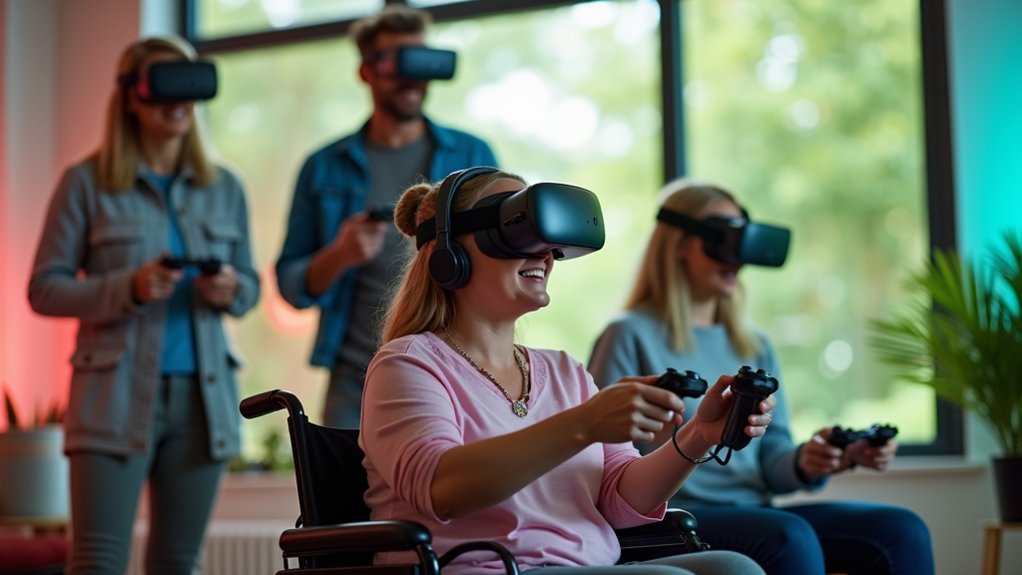



Leave a Reply